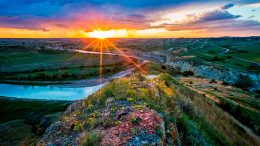These days many of us have a natural inclination to “doomscroll” — that constant refreshing of social media so we can gnash our teeth at the most recent bad news.
There’s an alternative. Let’s call it hopescrolling — the art and act of looking for beautiful things and important information to keep us inspired.
With the pandemic and election results still looming over our heads, here are 20 of our favorite nature- and environment-related Instagram accounts. May they fill your days with beauty and drive you to fight for the planet.
iNaturalist
Some of the best photos from the app that helps scientists and everyday citizens keep track of the natural world.
Joel Sartore
The famed National Geographic photographer is on a mission to capture the world’s biodiversity before it disappears.
Everyday Climate Change
Six photographers team up to showcase the very real effects of climate change around the world.
Virunga National Park
This park is famously home to mountain gorillas, but its account shows so much more.
Cornell Lab of Ornithology
All birds, all the time.
BBC Earth
We’ve all seen the documentaries, but there’s a lot more photos and videos to enjoy through this account.
Zoe Keller Art
One of The Revelator’s favorite nature artists. (Check out our interview with Keller here.)
Alex Wild
Among the world’s best insect photographers — and an important entomologist to boot.
Carls of Ohio
A groundhog that lives in a friend’s backyard. Hey — urban biodiversity matters.
The Caterpillar Lab
So much color, plus background on some species (and body stages) that we tend to overlook.
David Attenborough
The conservation icon doesn’t plan to be on Instagram very long — hey, he’s in his nineties — but this account is gold.
Drone the Whales
Amazing aerial footage of cetaceans around the world.
View this post on Instagram
Humpback whale creating rainbows! 📷: @markgirardeau 🚢: @newportcoastaladventure
Roger Peet
This amazing artist/activist frequently works with our parent organization, the Center for Biological Diversity, but that’s just a fraction of his inspirational output.
National Park Service
Not only does this agency help protect amazing landscapes, it also employs some incredibly talented photographers. And they share great tips.
Winona LaDuke
The famed Native American activist is a source of constant inspiration.
Public Lands Hate You
See what certain people do wrong when they try to celebrate the natural world — and remind yourself not to follow in their footsteps.
United Nations Environment Programme
This great account frequently features world-saving initiatives both large and small.
NASA Climate Change
Images and science about the planet. Expect lots of photos of melting icebergs.
International Dark-Sky Association
This organization is devoted to protecting us from light pollution, and these photos will inspire you to look up into the night.
The Center for Biological Diversity
Our parent organization’s Instagram account will both entertain you and keep you engaged in important activism. Just when you’re needed most.
![]()



